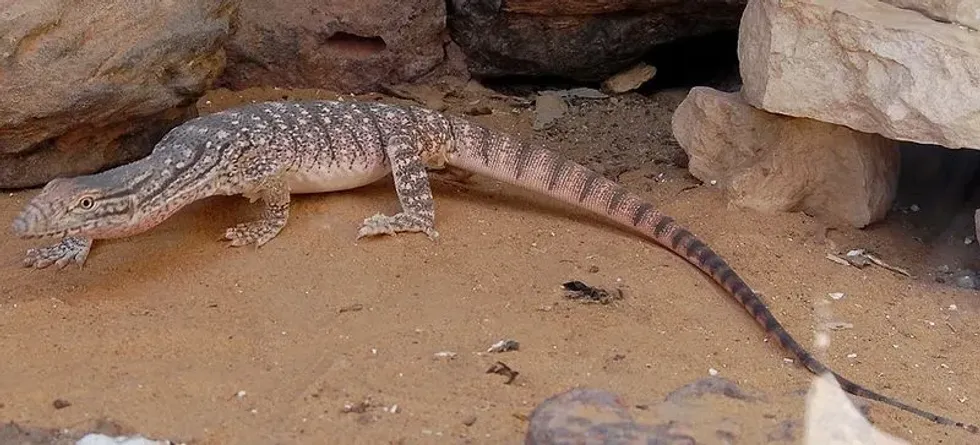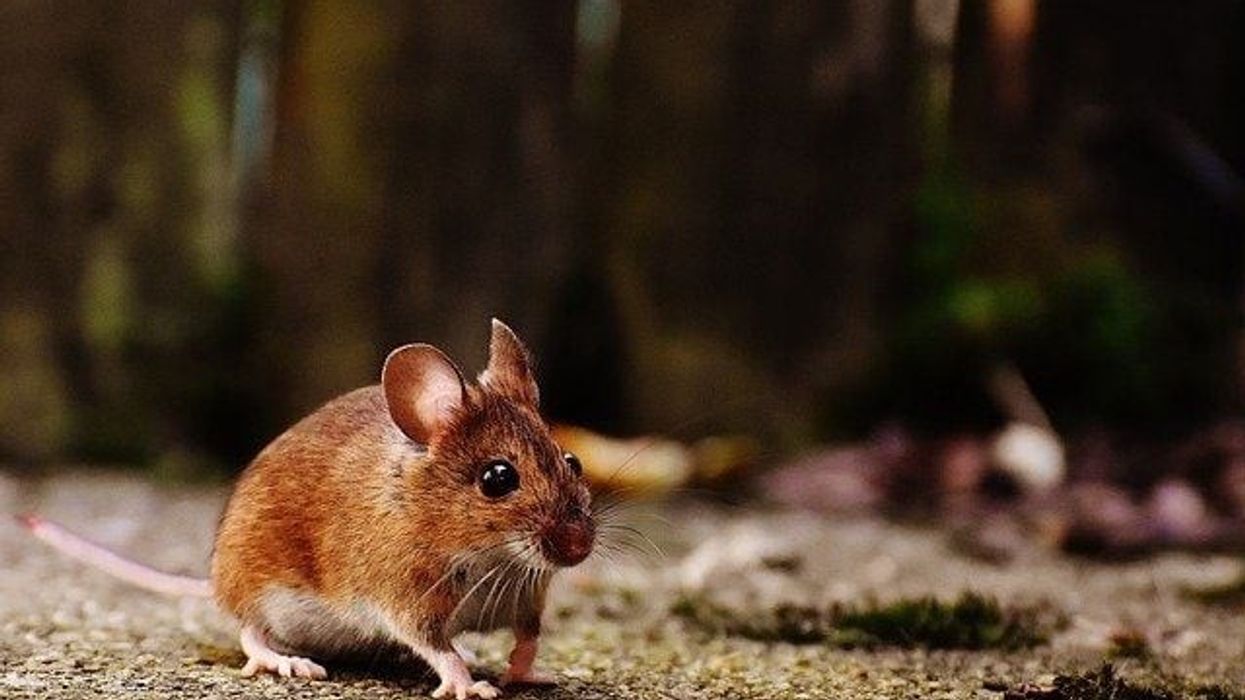A species of monitor lizard, the desert monitor, (Varanus griseus), belongs to the family of Varanidae and the order Squamata. The species is found in several countries of North Africa, South, and Central Asia.
The species is further divided into three subspecies known as the grey monitor (Varanus griseus griseus), Caspian monitor (Varanus griseus caspius), Indian desert monitor (Varanus griseus koniecznyi).
The adult lizards possess light brown, gray, or yellow bodies and horizontal bands either on their tails or backs. Young or juveniles have bright orange bodies.
Some lizards are 29.52 in (75 cm) long while the total length of a few subspecies can reach 78.74 in (200 cm). The average weight of the species is 1.14-6.28 lb (520-2850 g).
Male lizards are generally bigger than females. Also, the adult lizards go through shedding, a process in which the lizards shed the outer layer of skin that helps to expand the body size.
The species dwell in a wide range of habitats such as deserts, sandy areas, rocky areas but the lizards are also known for their exceptional swimming skills. The International Union for Conservation of Nature has declared the species as of Least Concern, but in several regions, the desert monitor is listed as an Endangered Species.
In several countries, the species is still hunted commercially.
Let's read more interesting facts about the desert monitor and if you found this article insightful, don't forget to check out exciting information about different animals like the monitor lizard and lava lizard.
Desert Monitor Interesting Facts
What type of animal is a desert monitor?
The desert monitor (Varanus griseus) is a species of monitor lizards. The species is a carnivore and primarily prey on rodents, eggs, small mammals, birds, insects, and many more. The species is further divided into three subspecies known as the grey monitor (Varanus griseus griseus), Caspian monitor (Varanus griseus caspius), and Indian desert monitor (Varanus griseus koniecznyi).
What class of animal does a desert monitor belong to?
The desert monitor belongs to the class of Reptilia, the family of Varanidae, and the Varanus genus.
How many desert monitors are there in the world?
The exact population of the monitor lizard is not known as of now, but the population of the species has gone down significantly for the last few decades. The desert monitor has been an endangered species in India and a statistic reveals that there are not more than 200 lizards in the Thar desert.
Where does a desert monitor live?
Research on the desert monitor distribution states that the species is found in several South and Central Asian countries such as Pakistan, India, Afghanistan, and many more. Also, the desert monitors are found in Egypt, Mali, Sudan, Chad, and several other countries of North Africa. The monitor lizard also inhabits the coastal regions of the Caspian Sea.
What is a desert monitor's habitat?
While talking about the desert monitor habitat, the species dwell in a wide range of habitats such as deserts, sandy areas, rocky areas. The lizard generally inhabits the burrows.
Who do desert monitors live with?
Just like other species of monitor lizards, the desert monitors are solitary animals and prefer to live alone. Also, the species is quite territorial and dwells in a large habitat. The lizards only come together during the breeding season.
How long does a desert monitor live?
Generally, the species of monitor lizards live for around 20 years but species like the komodo dragon can live up to 30 years. Also, research suggests that the size of the lizard determines the lifespan, thus the desert monitor lives for up to 10 years.
How do they reproduce?
The breeding season generally occurs during the months of May and July. Also, before breeding, these reptiles are generally involved in different courtship displays. Female lizard releases pheromones or chemicals to grab the attention of the males.
The gestation period of the species is not known but usually, it lasts for up to eight months. Females lay eggs in deep burrows and around 15-20 eggs are laid every season. It takes not more than four months for the eggs to hatch.
What is their conservation status?
While talking about the conservation status of the monitor lizard, the International Union for Conservation of Nature has declared the species Least Concern but in several regions, the desert monitor is listed as Endangered Species.
Also, the Convention on International Trade in Endangered Species of Wild Fauna and Flora or CITES have put a ban on skin trading but in several parts of India, North Africa, and Central Asia, the species is still being hunted.
Desert Monitor Fun Facts
What do desert monitors look like?

The adult lizards possess light brown, grey, or yellow-colored bodies and horizontal bands either on tails or backs. One can also observe the yellow spots on the back. These reptiles can reach the length of 78.74 in (200 cm), males are generally bigger compared to female lizards.
How cute are they?
Generally, these reptiles are considered scary rather than cute due to their huge size and venom glands. But watching them running and defending their territories would look so stunning
How do they communicate?
These reptiles primarily use their scent glands to communicate, their sensitive tongues help them to track the prey. Also, through body movements, touch, bite, these animals communicate with each other. Different courtship behaviors before breeding is also a way to attract the partner. These animals also make hissing sounds if they feel threatened.
How big is a desert monitor?
The desert monitor size is not quite big, some lizards are 29.52 in (75 cm) long while the total length of a few subspecies can reach 78.74 in (200 cm). The average weight of the species is 1.14-6.28 lb (0.5-2.8 kg). The desert monitor is twice the size of an iguana or a savannah monitor.
How fast can a desert monitor move?
The exact speed of the desert monitor is not known as of now but the species is known for its sprinting abilities while catching the prey.
How much does a desert monitor weigh?
The average weight of the species is 1.14-6.28 lb (0.5-2.8 kg).
What are the male and female names of the species?
There are no specific names given to the male and female desert monitors. The male lizard has a bigger body compared to the females.
What would you call a baby desert monitor?
No particular name has been given to the babies of desert monitors, people generally call them juveniles or young desert monitors. The young lizard has a bright orange-colored body.
What do they eat?
The desert monitors are carnivores and primarily prey on rodents such as mice, birds, reptiles, amphibians, insects like grasshoppers, small mammals, and eggs. It is also said that sometimes the females eat their own eggs.
Are they poisonous?
Apart from the strong body, the species possess venom glands that are situated in the mouths. The animals usually use their venom as a defensive mechanism to protect themselves from predators and big animals.
Also, these reptiles use venom while catching their prey, it is also proven that the venom produced by the species helps to maintain oral hygiene. Generally, the desert monitors are solitary animals and remain aloof from humans but it is always advised not to provoke or threaten these lizards.
To protect themselves, they could also attack humans. The attack is not deadly but can cause bacterial infection.
Would they make a good pet?
People generally do not keep the desert monitors as pets and often consider them hard to tame animals. A specific habitat is required to keep as they would not survive in man-made habitats. Also, the population of the species is coming down year by year, it is better to protect them.
Did you know...
The water monitor, also known as the Asian water monitor is also known for its venom. Just like the desert monitors, the venom produced by the water monitors is not lethal for humans but can cause bacterial infections.
How do monitor lizards survive in the desert?
Monitor lizards generally make burrows in which they dwell. The holes or burrows help these animals to prevent the scorching heat, the lizards only come out during finding the prey. The females also lay eggs in the burrows to protect them from predators.
Why is the desert monitor endangered?
The species is listed as Least Concern in the IUCN Red List but the current status reveals the accurate situation of the species. The major threats that made the species endangered are loss of habitat, poaching, skin trading.
The Convention on International Trade in Endangered Species of Wild Fauna and Flora, or CITES, has put a ban on skin trading but in several parts of India, North Africa, and Central Asia, but the species is still being hunted.
Here at Kidadl, we have carefully created lots of interesting family-friendly animal facts for everyone to discover! Learn more about some other reptiles from our sand lizard facts and Gila monster facts pages.
You can even occupy yourself at home by coloring in one of our Desert Monitor coloring pages.










